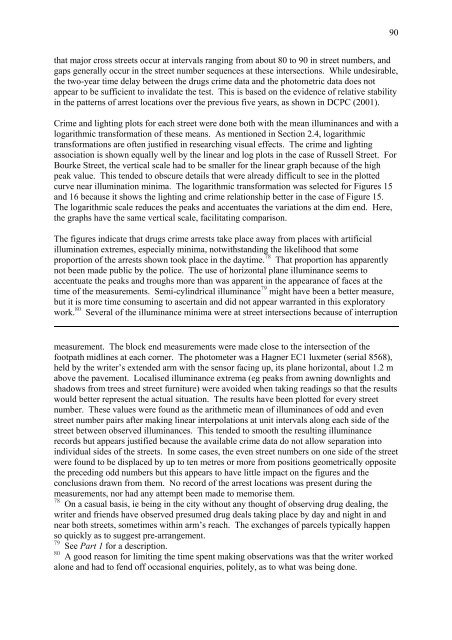Outdoor Lighting and Crime - Amper
Outdoor Lighting and Crime - Amper
Outdoor Lighting and Crime - Amper
Create successful ePaper yourself
Turn your PDF publications into a flip-book with our unique Google optimized e-Paper software.
that major cross streets occur at intervals ranging from about 80 to 90 in street numbers, <strong>and</strong><br />
gaps generally occur in the street number sequences at these intersections. While undesirable,<br />
the two-year time delay between the drugs crime data <strong>and</strong> the photometric data does not<br />
appear to be sufficient to invalidate the test. This is based on the evidence of relative stability<br />
in the patterns of arrest locations over the previous five years, as shown in DCPC (2001).<br />
<strong>Crime</strong> <strong>and</strong> lighting plots for each street were done both with the mean illuminances <strong>and</strong> with a<br />
logarithmic transformation of these means. As mentioned in Section 2.4, logarithmic<br />
transformations are often justified in researching visual effects. The crime <strong>and</strong> lighting<br />
association is shown equally well by the linear <strong>and</strong> log plots in the case of Russell Street. For<br />
Bourke Street, the vertical scale had to be smaller for the linear graph because of the high<br />
peak value. This tended to obscure details that were already difficult to see in the plotted<br />
curve near illumination minima. The logarithmic transformation was selected for Figures 15<br />
<strong>and</strong> 16 because it shows the lighting <strong>and</strong> crime relationship better in the case of Figure 15.<br />
The logarithmic scale reduces the peaks <strong>and</strong> accentuates the variations at the dim end. Here,<br />
the graphs have the same vertical scale, facilitating comparison.<br />
The figures indicate that drugs crime arrests take place away from places with artificial<br />
illumination extremes, especially minima, notwithst<strong>and</strong>ing the likelihood that some<br />
proportion of the arrests shown took place in the daytime. 78 That proportion has apparently<br />
not been made public by the police. The use of horizontal plane illuminance seems to<br />
accentuate the peaks <strong>and</strong> troughs more than was apparent in the appearance of faces at the<br />
time of the measurements. Semi-cylindrical illuminance 79 might have been a better measure,<br />
but it is more time consuming to ascertain <strong>and</strong> did not appear warranted in this exploratory<br />
work. 80 Several of the illuminance minima were at street intersections because of interruption<br />
measurement. The block end measurements were made close to the intersection of the<br />
footpath midlines at each corner. The photometer was a Hagner EC1 luxmeter (serial 8568),<br />
held by the writer’s extended arm with the sensor facing up, its plane horizontal, about 1.2 m<br />
above the pavement. Localised illuminance extrema (eg peaks from awning downlights <strong>and</strong><br />
shadows from trees <strong>and</strong> street furniture) were avoided when taking readings so that the results<br />
would better represent the actual situation. The results have been plotted for every street<br />
number. These values were found as the arithmetic mean of illuminances of odd <strong>and</strong> even<br />
street number pairs after making linear interpolations at unit intervals along each side of the<br />
street between observed illuminances. This tended to smooth the resulting illuminance<br />
records but appears justified because the available crime data do not allow separation into<br />
individual sides of the streets. In some cases, the even street numbers on one side of the street<br />
were found to be displaced by up to ten metres or more from positions geometrically opposite<br />
the preceding odd numbers but this appears to have little impact on the figures <strong>and</strong> the<br />
conclusions drawn from them. No record of the arrest locations was present during the<br />
measurements, nor had any attempt been made to memorise them.<br />
78 On a casual basis, ie being in the city without any thought of observing drug dealing, the<br />
writer <strong>and</strong> friends have observed presumed drug deals taking place by day <strong>and</strong> night in <strong>and</strong><br />
near both streets, sometimes within arm’s reach. The exchanges of parcels typically happen<br />
so quickly as to suggest pre-arrangement.<br />
79 See Part 1 for a description.<br />
80 A good reason for limiting the time spent making observations was that the writer worked<br />
alone <strong>and</strong> had to fend off occasional enquiries, politely, as to what was being done.<br />
90
















